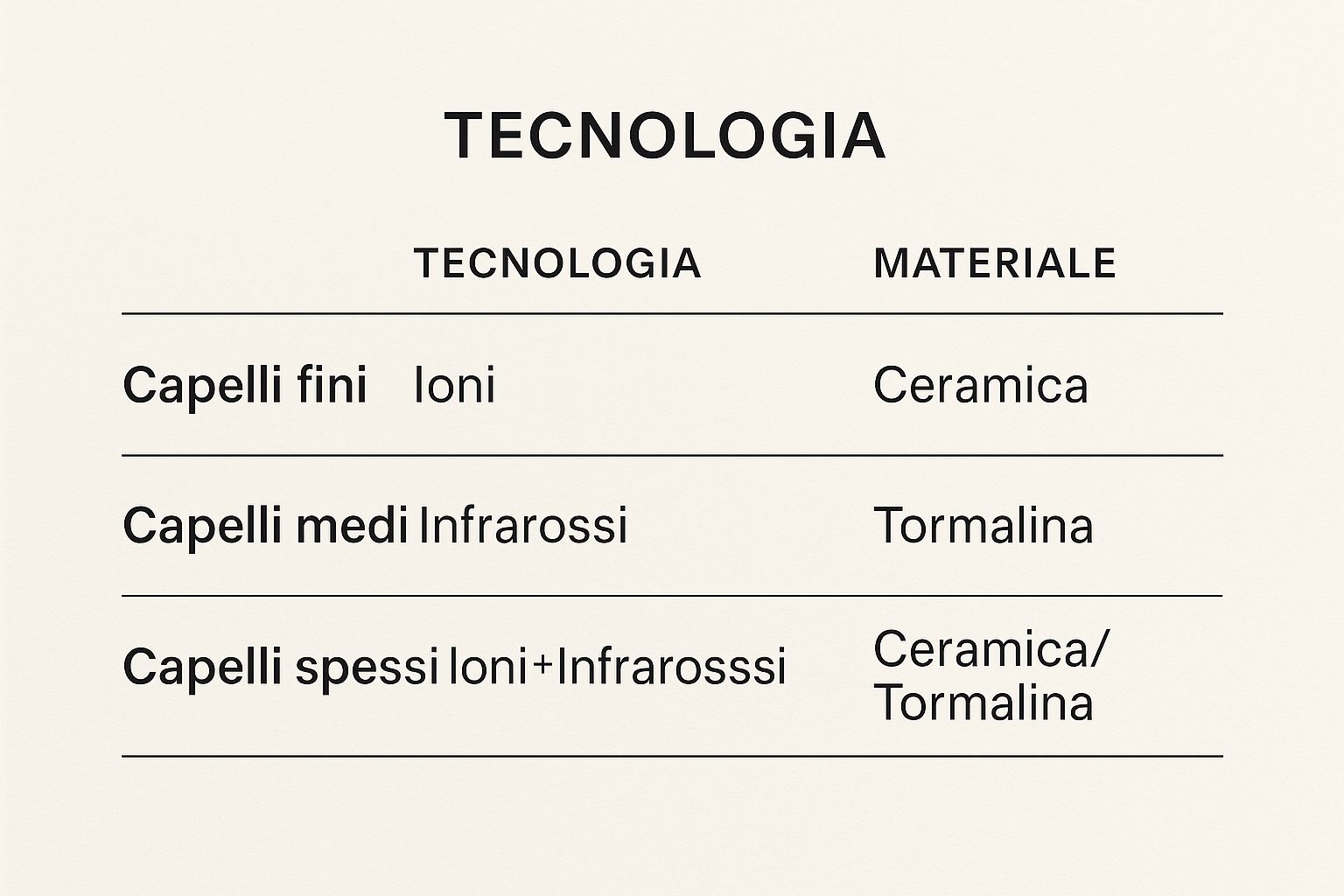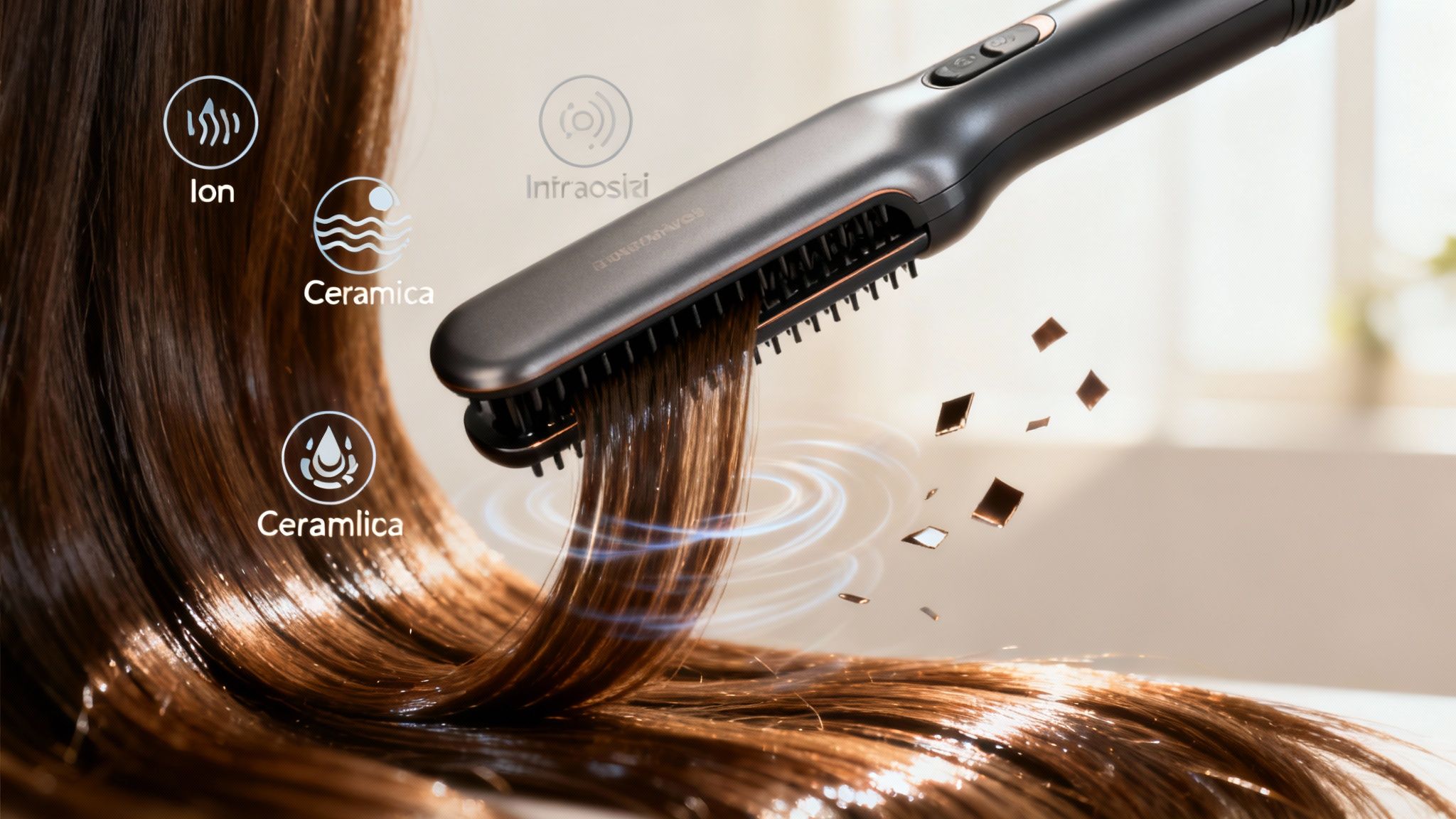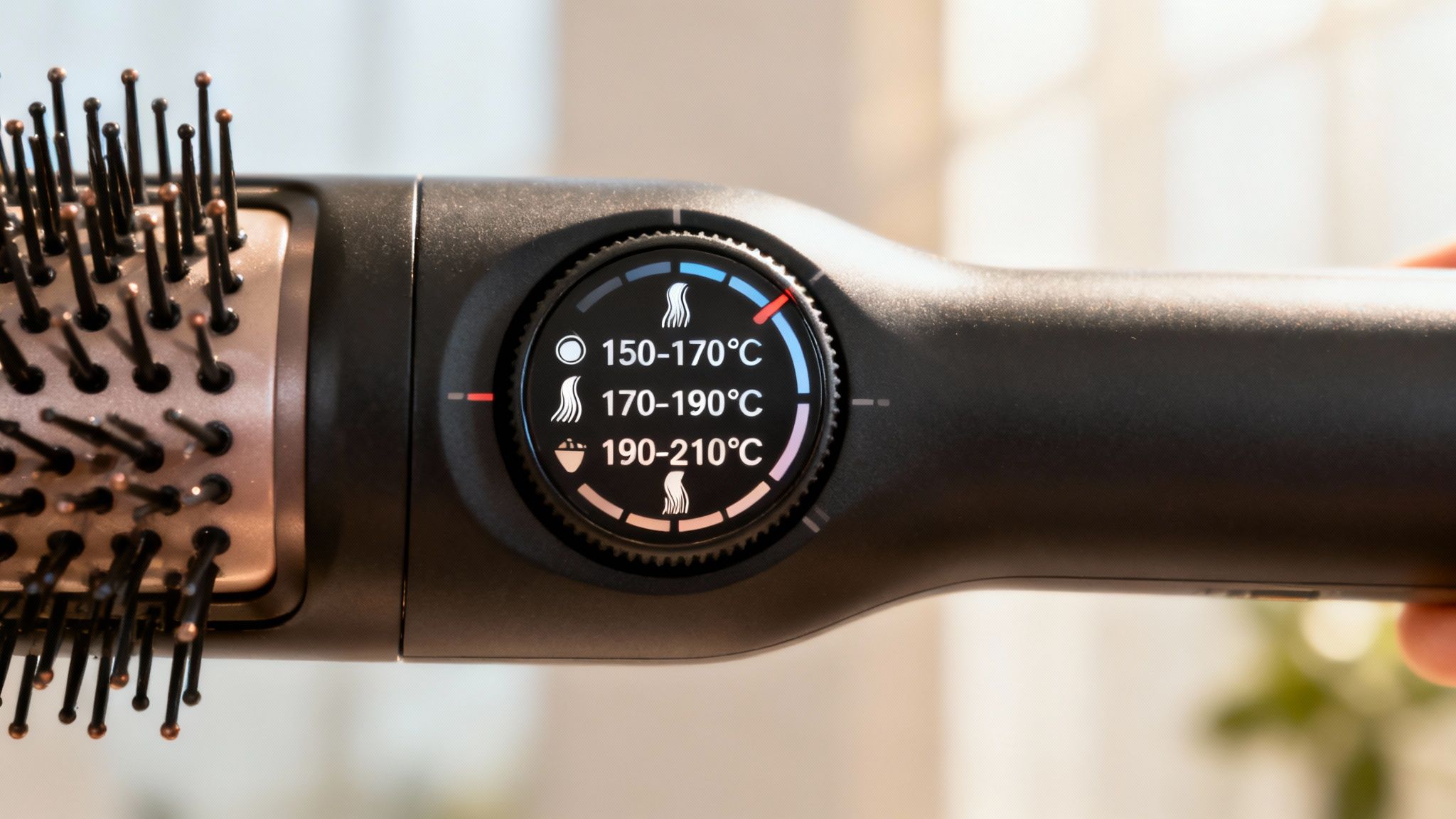Figuring out which straightening brush is best for you is all about knowing your hair and what results you want. If you have fine hair , for example, a ceramic model with ionic technology is almost always the best choice. On the other hand, if your hair is thick and unruly , you'll need the power of tourmaline combined with infrared heat to achieve flawless, long-lasting straightening.
How to find the best straightening brush for you
Choosing the right brush isn't just a matter of style, but a true gesture of care. Unlike a straightener that crushes hair between two hot plates, a straightening brush treats it more gently. While detangling, it smooths, preserving natural volume and avoiding that "flat" and slightly artificial look. It's a less aggressive solution, ideal for those who don't want to over-stress their hair.
To avoid making a mistake in your purchase, keep an eye on three fundamental aspects:
- Your hair structure: Fine, thick, wavy, or curly? Each type requires specific temperatures and materials to be perfectly straightened without damage.
- The technologies it uses: The ion function is your best ally against frizz. The infrared technology, on the other hand, works more deeply, ensuring a style that lasts longer.
- Bristle materials: Ceramic and tourmaline are the most popular, and for good reason. They distribute heat evenly, protecting the hair fiber from excessive heat.
This infographic helps you immediately visualize which combination is perfect for you.

As you can see, matching the right material and technology to your hair makes all the difference in the world, both in terms of results and hair health.
The real difference is in the final look. The straightener will give you a perfectly smooth, almost graphic look. The straightening brush, on the other hand, gives a much more natural, soft effect, full of volume. It's perfect for every day.
It's no coincidence that in Italy, approximately 60% of women with medium to fine hair prefer straightening brushes. This is precisely because they tame frizz without sacrificing body and softness. This data tells us that the tool should be chosen based on the desired effect, as hairstylists always explain.
If you want to discover more hair care tricks, check out the articles on our beauty blog.
Quick Comparison of Straightening Brushes
To give you an even clearer idea, we've compared some of the most common models in this table. It's a quick way to figure out which one might be right for you.
| Model | Ideal for Hair | Main Technology | Temperature Range | Price Range |
|---|---|---|---|---|
| Ceramic Brush | Fine, Normal, Wavy | Ions, Ceramics | 160-210°C | € |
| Tourmaline Brush | Thick, Curly, Frizzy | Ions, Infrared | 180-230°C | €€ |
| Rotating Brush | All types (by volume) | Hot Air, Ceramic | Low/Medium/High | €€€ |
| Steam Brush | Dry, Damaged | Steam, Ceramic | 150-230°C | €€€ |
As you can see, each technology has its own purpose and addresses a specific need. The choice depends entirely on you, the nature of your hair, and the time you want to dedicate to styling each morning.
Technology that makes the difference in styling
If shape and materials are the backbone of a good straightening brush, technology is its brain. It's precisely the built-in innovations that determine not only how effective the straightening will be, but also how well your hair will be protected during the process. Let's take a closer look at what's under the hood.
The most well-known feature—and for good reason—is the negative ion function. Essentially, the brush emits particles that neutralize static electricity in hair, the real culprit behind frizz. The result? Hair that's instantly shinier, softer, and incredibly manageable.

It's no coincidence that it's so in demand. Think about it: in Italy, the market share of hair appliances with ionic technology grew by over 35% from 2020 to 2024. This data speaks volumes about how much people are looking for tools that don't just style, but actively care for hair health. If you're interested in the topic, you can learn more about the evolution of these tools by reading industry analyses .
Infrared Heat and the Power of Coatings
Another technology not to be underestimated is infrared heat . Unlike conventional heat, which only warms the surface of the hair, infrared heat works deeper, warming it from within. The great advantage is that it reduces styling time and preserves the hair fiber's natural moisture.
To put it more clearly: infrared heat is like a convection oven for your hair, cooking it evenly and gently. Traditional heat, on the other hand, is more like a hot pan that only heats the surface, risking drying out or damaging the outer layer.
Finally, always pay close attention to the bristle coating materials. The undisputed stars here are ceramic and tourmaline , essential for distributing heat evenly and consistently, without dangerous fluctuations.
- Ceramic : Ensures that the brush glides through the hair smoothly and, above all, prevents the creation of excessive heat spots that could burn the strands.
- Tourmaline : A precious mineral that, when heated, naturally emits negative ions and infrared heat. This enhances the tool's anti-frizz and protective effects.
When these technologies work together, they transform a simple brush into a true beauty ally, capable of giving you impeccable styling while respecting the health of your hair.
Materials, design, and ergonomics: what really makes the difference
When looking for the best straightening brush , don't just rely on technology. The true quality of a tool is evident in its construction. High-quality materials and a thoughtful design are the secret to effective, safe, and enjoyable styling over time. After all, the choice of materials directly impacts the device's durability and, above all, the health of your hair.
Take bristles, for example. Their arrangement and the material they're made of completely change the way the brush works.
- Ceramic bristles: These are the heart of the brush. Ceramic is fantastic because it distributes heat evenly across the entire surface, preventing heat spikes that can literally fry your hair.
- Silicone or nylon bristles: Often located on the sides or tips, they remain cool to the touch. Their function is twofold: they detangle hair, preparing it for the heat and protecting the scalp from direct contact with the hot parts.
It is precisely this intelligent combination that distinguishes a high-end product from a mediocre one, allowing you to straighten your locks with complete confidence.
The importance of a comfortable grip and practical design
Beyond materials, ergonomics is a factor you can't ignore. A heavy or poorly balanced brush will tire your arm in no time, making styling a real chore, especially if you have long, thick hair. Therefore, always look for a lightweight model with a handle that fits snugly in your hand for total, effortless control.
And then there's the cable. A seemingly small detail, but it can make a huge difference in everyday use. A short, stiff cable is a constant source of frustration, limiting your movement and forcing you into awkward positions.
Functional design isn't a luxury, but a necessity. Features like a 360° swivel cord and a convenient length transform a potentially awkward task into a simple and fluid gesture, significantly improving the user experience.
The standard length for professional models, such as those from GHD with a 2.7-meter cord, is designed to ensure maximum freedom, both at home and in the salon. This attention to practicality, as highlighted in many online beauty guides , is a sign of quality. Remember that combining well-designed tools with a comprehensive care routine is the best way to enhance the health of your skin and hair. In this regard, you might also be interested in our article on the heated neck massager for a 360-degree wellness ritual.
Finding the right temperature for your hair
Using the best straightening brush at the wrong temperature is a bit like driving a luxury car in first gear only: not only are you not getting the most out of its potential, but you also risk damaging it. Choosing the right temperature isn't a minor detail, but the real secret to achieving perfect straight hair without sacrificing hair health.
Every hair has its own history and structure, so the temperature should be adjusted individually. The golden rule is always the same: start low and, if necessary, gradually increase. This way, you'll understand how your hair reacts without unnecessarily stressing it.

A starting point for every hair type
To get your bearings, you can use these instructions as a starting point. But remember, these are just guidelines: the most important thing is to observe your hair's reaction and adjust the temperature accordingly.
-
Fine, treated, or fragile hair (between 150°C and 170°C): If you have fine, bleached, or easily breakable hair, the key is gentleness. Too much heat could permanently damage the cuticle. Staying within this range ensures effective yet gentle straightening.
-
Normal or wavy hair (between 170°C and 190°C): This is the ideal range for most people. You'll find the right balance between flawless results and heat protection, achieving defined, long-lasting straightness without having to go over your locks a thousand times.
-
Thick, curly, or difficult-to-tame hair (between 190°C and 210°C): Thicker hair or hair with a very curly texture needs an extra boost to style. Going above 200°C is an option only if your hair is really resistant, and never without first applying a good heat protectant.
The secret isn't to use the highest heat possible, but to find the lowest heat that gives you the result you're looking for in a single, slow, and consistent pass. Repeating excessive heat on the same strand is the fastest way to damage your hair.
Knowing how to manage heat makes all the difference. Transform your brush from a simple accessory to a precision tool, giving you salon-quality styling while keeping your hair healthy and shiny for longer.
How to use a straightening brush for fabulous straight hair
Having the best straightening brush in your hands is a great starting point, but the real secret to flawless results lies in how you use it. To achieve a salon-quality blow-dry, preparation is essential. Let's get one thing straight: never, ever use a brush on even slightly damp hair. The risk of seriously damaging it is too high.
The first step, which is essential, is to work on completely dry and well-detangled hair. Armed with a wide-toothed comb, carefully untangle every single knot, always starting from the ends and working your way up toward the roots. This prevents breakage and ensures the brush can glide freely.
Before turning on your brush, don't forget your heat protectant. Choose a good-quality one and spray it evenly over your hair. Think of this product as an invisible shield that protects your hair from heat, keeping it hydrated and shiny. It's a gesture that, in the long run, really makes a difference to the health of your hair.
The right technique for a perfect result
To achieve even, smooth results, avoid brushing haphazardly. The key is precision: divide your hair into medium-sized sections and secure them with clips. This way, you'll treat each strand with just the right amount of heat, ensuring perfectly smooth hair from root to tip.
Now take the first section. Bring the brush close to your scalp with the bristles facing upward, and with your other hand, hold the section slightly taut. Slowly slide the tool through, using a continuous, controlled motion, all the way to the ends. Slowness is your best friend: a slow stroke is much more effective and less stressful for your hair than many quick, hasty strokes.
Want a little volume? When you reach the roots, lift the section upward and hold the brush in place for a few moments before moving down. If you prefer softer, more sculpted ends, rotate the brush inward or outward in the last few inches of the section.
Once you've finished styling all the sections, let your hair cool for a few minutes; this little trick helps set the style and make it last longer. For the finishing touch, apply a thin layer of shine serum or a few drops of argan oil to the lengths. This will seal the cuticles, eliminate residual frizz, and achieve spectacular shine.
By following these simple steps, your straightening brush will become your favorite tool for professional styling at home.
Our selection of the best straightening brushes
Now that we've taken a closer look at technologies, materials, and the proper way to use them, it's time to get down to business. Which models truly stand out on the market? This isn't a simple ranking, but a thoughtful selection to help you find the best straightening brush for you, whether you have fine, brittle hair, thick, untamed mane, or simply want a stress-free, professional result.
The ideal option for fine and delicate hair
Anyone with fine hair knows it well: the risk of burning or damaging it with heat is a constant worry. The GHD Glide model is a true guarantee of peace of mind. Its ceramic technology with ionizer operates at a constant temperature of 185°C , and this is not a value chosen at random. It's the perfect balance for effective straightening without damaging the hair fiber.
Plus, the smart design with high-density bristles of varying lengths allows you to manage larger sections of hair. This translates into fewer strokes and less heat exposure. In short, it's the ideal choice if you're looking for gentleness and effectiveness in a single tool.
The solution for thick and unruly hair
When you're dealing with thick, curly, or particularly stubborn hair, you need an extra boost. The Tymo Ring Plus brush meets this need with its heated titanium bristles, a material that not only reaches higher temperatures but distributes them impeccably to tame even the most difficult locks.
The real ace in the hole for this model is the Nano Titanium Coating technology. It doesn't just straighten, it creates a sort of shield against humidity. The result? Smoothness that holds, without that annoying frizz that appears at the first cloud.
The best value for money
If you want excellent performance without having to invest a fortune, the Remington Keratin Protect is a smart choice. Its distinctive feature is its ceramic coating enriched with keratin and almond oil. During styling, these substances are released into the hair, nourishing it and giving it noticeable shine.
Despite its affordable price, it doesn't sacrifice versatility: it offers three different temperature settings, so you can choose the one best suited to your hair. It's proof that you don't have to spend a fortune to get quality results while also taking care of your hair. And if you're looking for an even more versatile option for your hair and beard, check out the features of the multifunctional straightening brush and styler available in our store.
Straightening brushes: the most common doubts
Do you have any questions about your straightening brush? Don't worry, it's normal. Here, we'll address the most frequently asked questions to help you use it effectively and safely.
Can I use it on wet hair?
The answer is a resounding no. A straightening brush should only be used on 100% dry hair . Using it on even slightly damp strands creates a violent thermal shock that can literally fry and break the hair. Dry first, then straighten. Always.
What is the difference with a classic straightener?
Think of them as two tools with different goals. The straightener "straightens" the hair by crushing it between two hot plates, giving it that super-defined, almost spaghetti-like smoothness.
The straightening brush, on the other hand, works more delicately. As it combs and detangles, it distributes heat evenly, smoothing hair without flattening it. The result is a more natural, soft, and full-bodied straight look that maintains your hair's original volume.
Article created using Outrank

